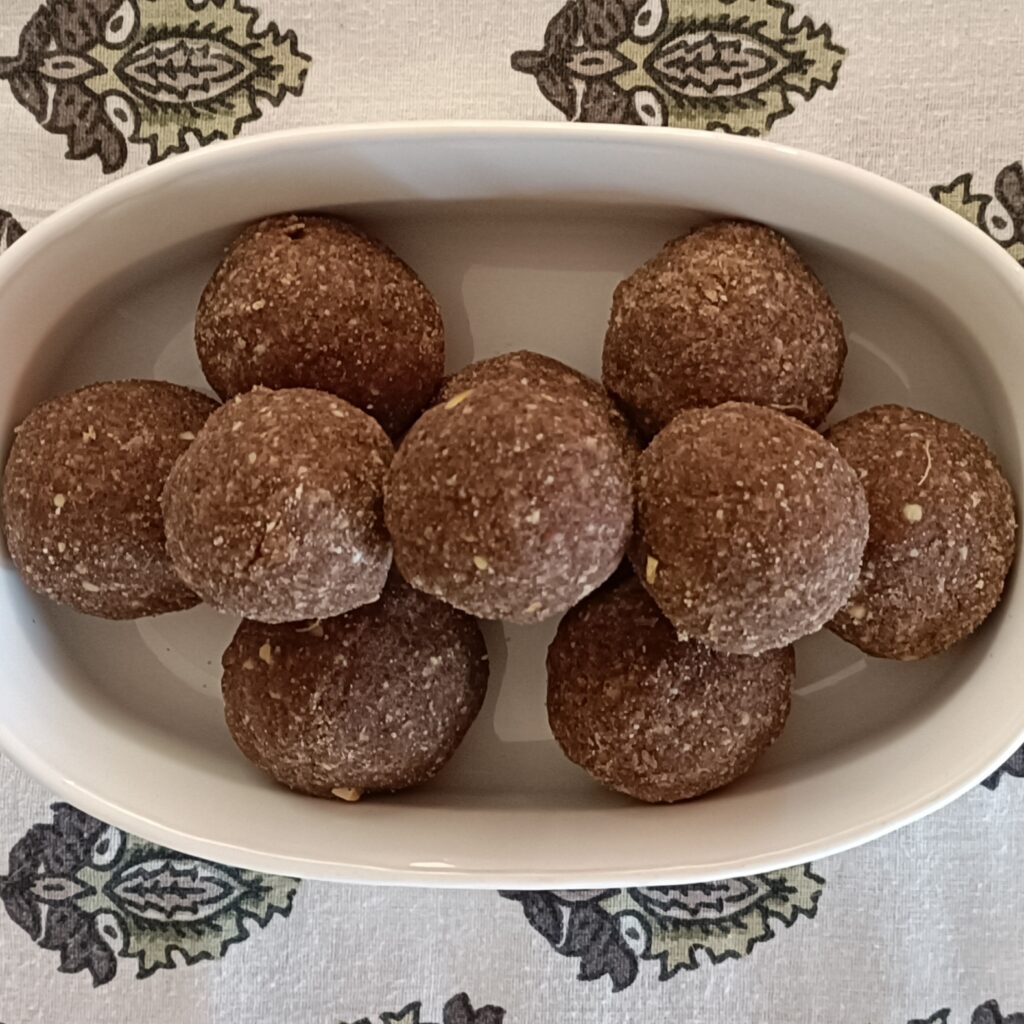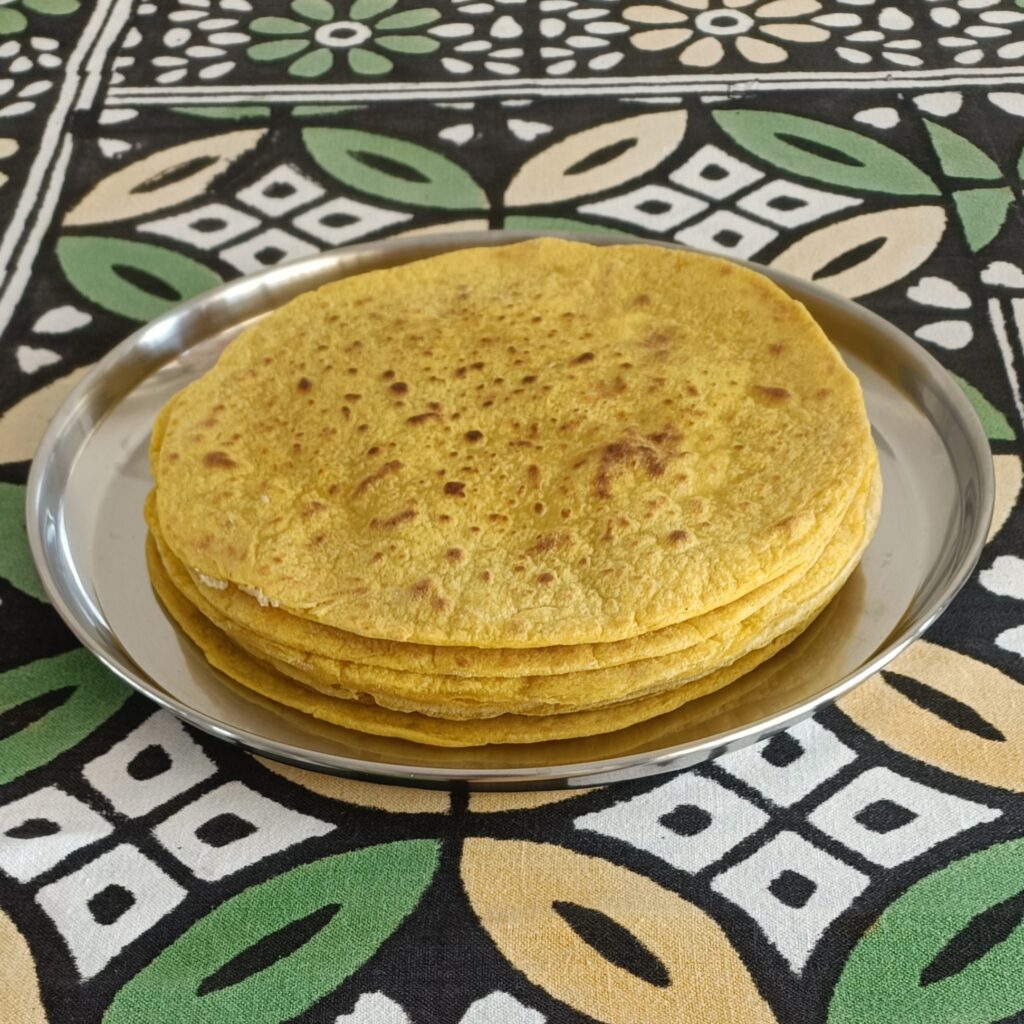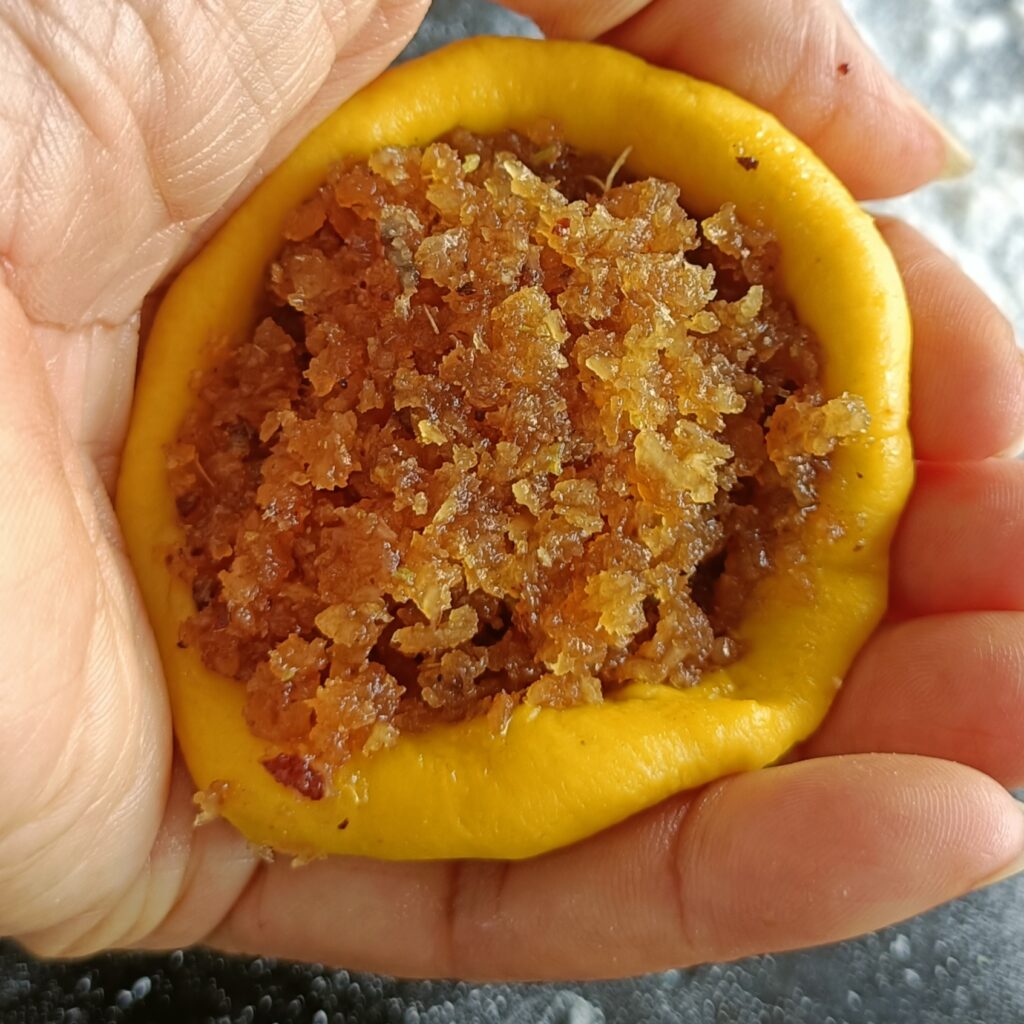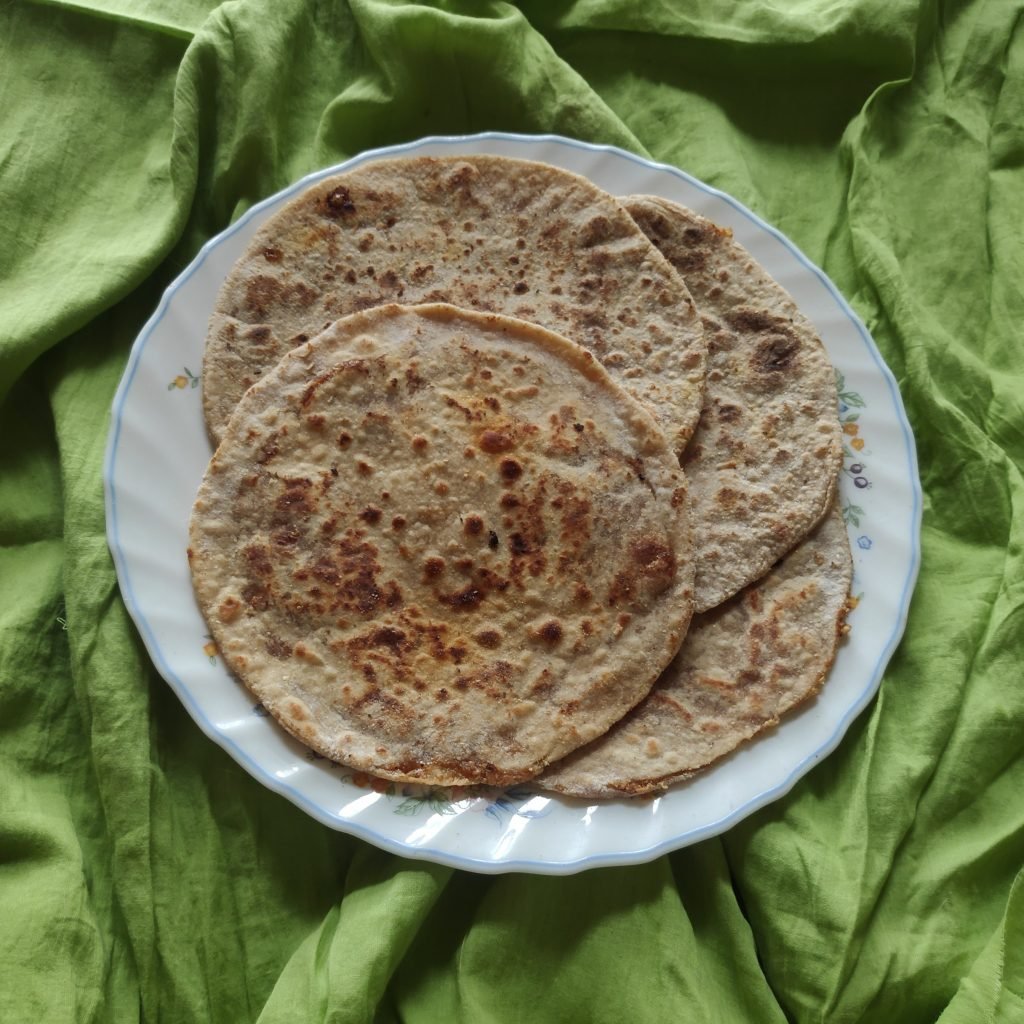
Ragi Laddu or Ragi Ladoo (Finger Millet Sweet Balls)
Recipe: Darshana Muzumdar Makes 10 large lime sized laddus Ingredients Method For the Whole-Food Plant-Based (WFPB) version: This version of the laddu is definitely more

Recipe: Darshana Muzumdar Makes 10 large lime sized laddus Ingredients Method For the Whole-Food Plant-Based (WFPB) version: This version of the laddu is definitely more

Tausoli is a simple easy to make snack that is usually made during the monsoons and especially during the festival of Ganesh Chaturthi. Traditionally this dish is made with Malabar cucumbers. A Malabar cucumber or yellow cucumber, dosakai, or sambar cucumber, is a variety of yellow-striped cucumber common in South India. It is oval in shape and is dark green with yellow stripes, has a crunchy, watery, off-white flesh, and a mild, floral taste. Malabar cucumbers are nutritious and are commonly also used in South Indian sambar, curries, and chutneys. In Saraswat cuisine, it is also used to make morning pancakes with rice flour and in sweet idlis.

Sanjori is the Marathi word for the Konkani Sanjiryo. It’s a delicious flat bread that’s stuffed with a sweet semolina stuffing. It’s similar to puran poli and naral poli, but isn’t made as often. Once you make it, you will be tempted to make it more often. Wheat is generally considered an acid-forming food because it produces more acid waste during its metabolism. Wheat provides carbohydrates (mainly starch), fiber, protein (including gluten), B vitamins, vitamin E, and minerals like iron, magnesium, phosphorus, and potassium. Whole grains are richer in nutrients than refined grains, containing significant amounts of dietary fiber and antioxidants. While beneficial for most, wheat can trigger gluten-related disorders in susceptible individuals. Excessive sugar consumption can lead to an acidic environment within the body. An acidic environment triggered by excess sugar can lead to the release of cortisol, a stress hormone, which can contribute to inflammation.

Just one cup or around 80 grams of fresh, shredded coconut meat contains almost 300 calories and 27 grams of fat, most of which is saturated fat. Although coconut contains beneficial minerals like manganese that supports enzyme function and fat metabolism, a good amount of selenium, and copper that assists bone formation and supposedly heart health, it should be consumed in limited quantities because of the high amount of fat which is definitely not good for the heart. Most of the saturated fat in coconut is in the form of medium-chain triglycerides (MCTs), which are absorbed intact in our small intestine and used by our body to produce energy. On the other hand, coconut is also rich in insoluble fibre, which doesn’t get digested but helps to move food through our digestive system and aids bowel health. The high fibre also is the reason that we cannot eat too much coconut, which of course is good!

Peanuts are a nutrient-rich food, packed with protein, healthy fats, fiber, vitamins, and minerals. There is a good amount of dietary fiber in peanuts, which aids in digestion and promotes satiety. However, they also contain phytic acid, which can reduce the absorption of some minerals. They are relatively low in carbohydrates but are calorie dense and so are a good source of energy, especially for young children. The high content of fat in peanuts, though unsaturated including monounsaturated and polyunsaturated fats (which are considered healthy), removes them from the list of ideal ingredients to manage weight. Peanuts are also rich in various vitamins and minerals, such as niacin, vitamin E, folate, manganese, magnesium, potassium, and phosphorus and in antioxidants like resveratrol, which can help protect against oxidative stress and inflammation. Some studies suggest that certain compounds in peanuts, like niacin, may play a role in brain health and cognitive function. The glycemic index (GI) of peanuts is low: around 14. This means that eating peanuts causes a slow and gradual increase in blood sugar levels, making them a good snack option. However, they are rich in fat so higher consumption of peanuts may add to the causes for diabetes. Peanuts are generally considered to have a near-neutral or slightly acidic pH. Raw peanuts have a pH of around 6.9, which is very close to neutral (pH 7), while roasted peanuts have a pH closer to 6.3, slightly more acidic than raw peanuts but still considered low-acid. While peanuts themselves are not acidic, they are considered “acid-forming” in the body. This means that after digestion, they can contribute to a more acidic environment in the body and should be consumed in limited quantities. Some individuals may experience acid reflux or heartburn after consuming peanuts, particularly those with GERD. This is because peanuts are higher in fat than some other nuts, and high-fat foods can sometimes trigger acid reflux. Jaggery, unlike refined sugar, contains a variety of minerals and vitamins, making it a more nutritious sweetener. It’s a good source of iron, calcium, magnesium, potassium, and phosphorus. Additionally, jaggery provides trace amounts of zinc, copper, and vitamins like A, B-complex, C, and E. The glycemic index (GI) of jaggery is 84.4, which places it in the high GI category. Foods with a high GI are digested and absorbed quickly, leading to a rapid spike in blood glucose levels.
Moong beans are one of the best sources of protein as they’re rich in many essential amino acids. (Essential amino acids are those that your body is unable to produce on its own.) Also, the carbohydrates in moong beans seem to be easier to digest than those found in other legumes and are therefore less likely to cause flatulence compared to other types of legumes. Sprouted moong beans contain fewer calories and more free amino acids and may contain as much as six times more antioxidants than regular mung beans than unsprouted ones. Sprouting also reduces the level of phytic acid, which is an antinutrient that can reduce the absorption of minerals like zinc, magnesium and calcium. Mung beans contain many healthy antioxidants, which help neutralize potentially harmful molecules known as free radicals. High amounts of free radicals are linked to chronic inflammation, heart disease, cancers and other diseases. Test-tube studies have found that antioxidants from mung beans can neutralize free radical damage linked to cancer growth in lung and stomach cells. Moong beans are believed to have anti-inflammatory properties that help protect against heat stroke and high body temperatures. Research also shows that mung beans may have properties that can lower LDL or bad cholesterol. Moreover, moong beans may help lower blood pressure as they’re a good source of potassium, magnesium and fibre. Moong beans are high in fibre so are great for digestive health and the soluble fibre (called pectin) in found in moong beans can help keep your bowels regular by speeding up the movement of food through the intestine. Moong beans, like other legumes, also contain resistant starch, which works like soluble fibre that helps nourish your healthy gut bacteria. The bacteria then digest it and turn it into short-chain fatty acids — butyrate, in particular, which has been shown to nourish colon cells, boost the gut’s immune defences and even lower the risk of colon cancer.

The Myndoli banana, also known as the Moira banana, is a large culinary-type banana that is popular in Goa, India. It is cultivated in areas along the tributaries of the Chapora and Mapusa rivers, particularly in Pernem, Bicholim, and Bardez talukas. The Myndoli banana is deeply ingrained in Goan culture and is a valuable gift, particularly during festivals and celebrations. These bananas are fleshier than most other bananas, have a tusk-shaped appearance, are long and large in size, and are distinctively sweet in taste. The skin of the Myndoli banana naturally transforms from green to golden as it ripens and develops black spots. Myndoli bananas are used in various dishes like halwas, sheera, etc. as well as in shakes. Like most bananas, the Myndoli banana is also a nutritional powerhouse and is rich in energy because of the naturally occurring sugars. It also provides vitamins like vitamin C, minerals like potassium and magnesium and a good amount of fibre. Vitamin C is important for immune function and antioxidant protection. Potassium is essential for heart health and fluid balance. magnesium plays a big role in making our body work right. More than 300 chemical reactions inside our body depend on this valuable mineral. Without magnesium, our muscles can’t move properly, and our nerves can’t send and receive messages. Magnesium also keeps the heart rhythm steady, blood sugar levels balanced, and our joint cartilage healthy. It helps the body make protein, bone, and DNA. Dietary fiber aids digestion and can contribute to feelings of fullness.

Mango is native to India and Southeast Asia, and people have cultivated it for over 4,000 years. Hundreds of types of mango exist, each with its own characteristic taste, shape, size, and color. This traditional drink contains vitamins C and A, fiber, and antioxidants because cooked mangoes generally retain their core nutritional value. Antioxidants are important because they protect our cells against free radicals. Free radicals cause damage and may hasten aging and be the cause of chronic lifestyle diseases. The vitamin C in mangoes can help our body produce more disease-fighting white blood cells, help these cells work more effectively, and improve our skin’s defenses.

Millets are hardy small-seeded annual grasses that are cultivated as grain crops and grow in adverse weather conditions. They also require much less water and care as compared to grains like wheat or rice.
Ragi, like most other millets, is usually soaked overnight or for at least 12 hours to ‘activate’ the fibre in it. It is then dried in the sun for a few hours before being roasted and powdered to be ready for use. Traditionally, we Indians harvested rain fed nachni, sprouted it to get the nutrients to an optimal level, dried it and then ground it to a fine powder. This powder was sieved to get the nachni ‘satva’, cooked in water, sweetened, and used to wean babies off mother’s milk.
Ragi/Nachni is rich in niacin (vitamin B3), and especially minerals like calcium and iron because of which it has traditionally been used to feed infants and babies and to keep anaemia at bay in children. Sprouted ragi is also rich in vitamin C that helps absorb iron better.
Ragi/Nachni (finger millet) is rich in complex carbohydrates which may help in preventing blood glucose levels from spiking after a meal as they take longer to digest thus releasing energy slowly and keeping one satiated for a longer time. The dietary fibre may help to control the ‘bad’ cholesterol and raise ‘good’ cholesterol levels and lower triglycerides. The soluble fibre in ragi absorbs cholesterol before it enters the bloodstream whereas the insoluble fibre acts like a prebiotic supporting the good bacteria in the gut.

The combination of sesame seeds and jaggery is a very common one in India and is used to make many traditional sweet dishes.
Sesame seeds contain protein, fiber, and healthy fats and are rich in calcium. Calcium is an essential mineral that supports the health and function of muscles, hormones, blood vessels and nerves. One tablespoon of sesame seeds provides 87.8 mg of calcium. Both the calcium and magnesium in the seeds may help to reduce blood pressure. Sesame seeds also provide B vitamins, vitamin E, and antioxidants. Sesame seeds are eaten as they are or are added as an ingredient to meals. Sesame seed oil is also used in cooking.
Jaggery is made using traditional methods of pressing and distilling palm or sugar cane juice. In India it is mainly made from sugar cane juice. Though jaggery contains more nutrients than refined sugar (which is only empty calories) because of its molasses content, it is still mostly sugar. The nutrients it contains are in small quantities and so any extra nutrients you get from jaggery come with a lot of calories and so should be eaten in moderation.